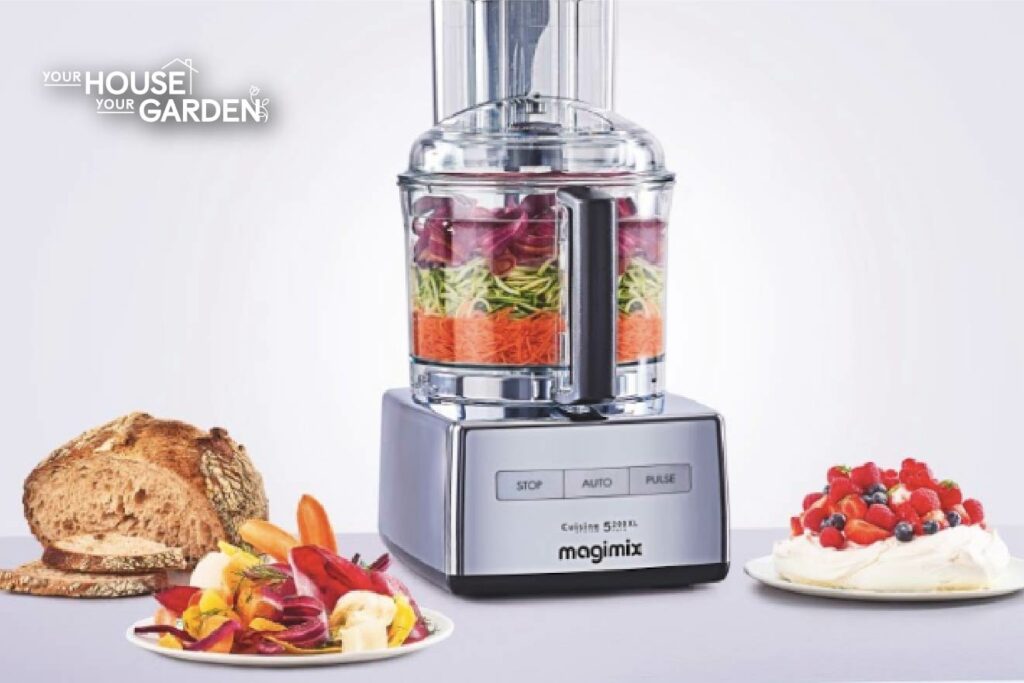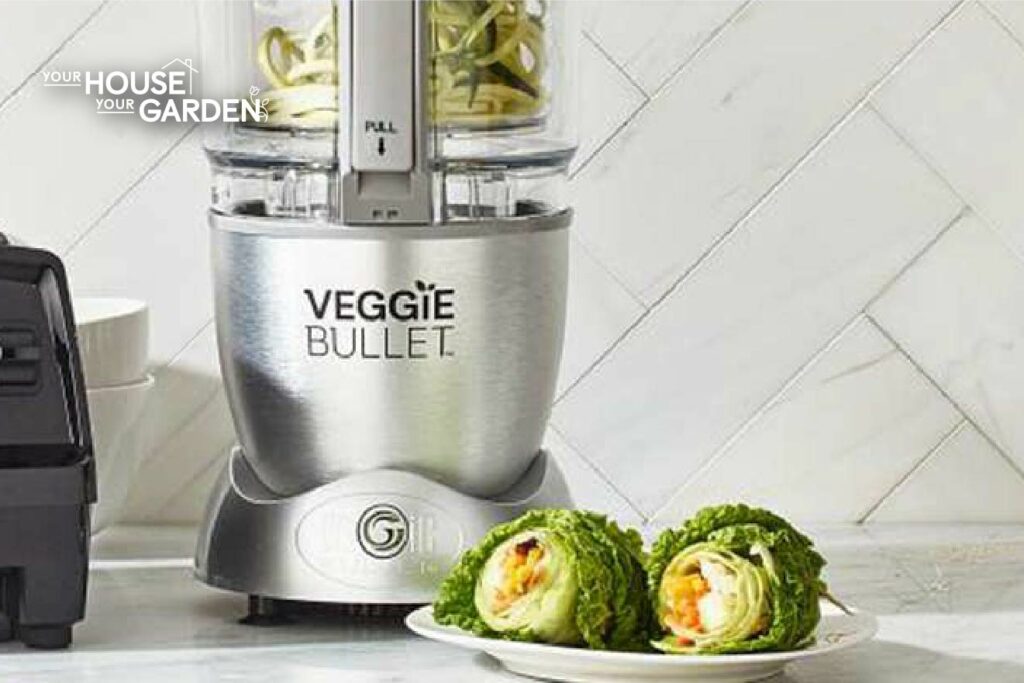A food processor is a small appliance used to prepare foods for cooking. Food processors are capable of all types of preparation tasks, including chopping, shredding, mixing, and grinding.
The primary purpose of a food processor is to reduce the time it takes to prepare foods for cooking. The preferred type of food processor is made with stainless steel materials. Food processors are also available in other materials, including plastic. Stainless steel food processors cost more than plastic food processors but are more durable and last longer.
Food processors are tall with a container for the ingredients. They have a stainless steel blade that chops or mixes the ingredients. Food processors come in all different sizes, so you can choose one that fits your cooking needs.
The history of food processors dates back to the mid-1940s. However, the first automated food processor didn’t come out until 1971.
Materials for Food Processor
The best material for food processors is stainless steel. Stainless steel food processors are durable and long-lasting. Stainless steel food processors are less likely to rust or break off into the food being prepared.
A stainless steel food processor costs more than plastic food processors but doesn’t have to be replaced as often. Food processors are also made with metal or ceramic materials. A metal or ceramic food processor costs less than a stainless steel food processor but more than a plastic food processor.
People who are concerned about environmental health may want to choose a stainless steel food processor. There have been some concerns about plastic parts peeling off into food.
Types of Food Processors
The types of food processors include:
- Batch bowl food processor: Batch bowl food processors are ideal for small to medium-sized ingredients. They work by adding a single batch of ingredients to the bowl to process. Batch bowl food processors have functions available for chopping, slicing, shredding, grating, whipping, and pureeing.
- Continuous feed food processor: A continuous feed food processor allows you to continually add ingredients to the food processor. They are ideal when you have a lot of ingredients you need to process. Continuous feed food processors are capable of heavy-duty slicing, shredding, grating, and precise dicing.
- Combination food processor: A combination food processor has both a batch and continuous feed option.
- Buffalo chopper: A buffalo chopper food processor is good for chopping dense ingredients, like meats.
- Vertical cutter processor: A vertical cutter processor has a heavy-duty motor with the ability to chop large ingredients at one time.
Sizes of Food Processors
Food processors come in all different sizes. The size of the food processor directly affects the size and number of ingredients you can chop at one time. The smallest food processors hold around three cups and the largest food processors hold up to 20 cups. If you have a small household, a 3-5 cup food processor may be sufficient. If you need a food processor for commercial purposes, you may want one of up to 20 cups.
Does Size Affect Food Processor’s Usage?
Yes, the size of a food processor affects how many ingredients you can process at once. If you choose a food processor that is too small, it may not chop ingredients into as small of pieces as you prefer. If you choose a food processor that is too large, you may find it difficult to process foods, and it may take longer.
The power of the food processor also affects usage. If you want to chop solid ingredients, like carrots or celery, you may want to choose a food processor with up to 600 watts.
Use Cases of Food Processor
Food processors allow you to buy store-bought ingredients and prepare them for more complex meals. A few use cases of food processors include:
- Grind or mince herbs
- Slice vegetables, like carrots or celery
- Shred or grate cheeses
- Chop meats
- Puree juices into liquids
- Mix or blend ingredients together
- Knead dough for bread
- Blend ingredients for hummus
- Whip potatoes
- Toast breadcrumbs
- Create cranberry or other sauces
Once you learn how to use a food processor, you’ll find that it has many uses beyond that of chopping and cutting foods.
Do Food Processors have Health Benefits?
Yes, food processors can help to promote healthy cooking. Food processors help speed up the time it takes to prepare ingredients, which can encourage more fresh eating. Making meals at home can also lead to lower sodium or cholesterol intake. Food processors make preparing healthy meals a lot easier.
Most Known Food Processor Brands
The best food processor brands right now include the following:
- Best overall food processor brand: Breville
- Best continuous feed food processor brand: KitchenAid
- Best batch feed food processor brand: Cuisinart
- Best smart food processor brand: Bosch

Food Processor Lifespan
The typical lifespan of a food processor is between 7-10 years. The initial quality and upkeep of a food processor affect how long it lasts. The factors that influence the lifespan of a food processor include:
- Frequency of use: How often you use your food process affects how long it lasts. If you use your food processor to prepare ingredients daily, it will wear out faster.
- Initial quality: The initial quality of a food processor also affects how long it lasts. A stainless steel food processor lasts longer than a plastic food processor.
- Cleaning and maintenance: Keeping up with cleaning and maintenance tasks can help your food processor last longer. This includes cleaning all food out between uses.
- Repairs: Making immediate repairs can help the food processor last longer. This includes changing the blades when they get dull.
The cost of a food processor ranges from $20-$400. The brand and material directly affect how much you can expect a food processor to cost. Smaller, plastic food processors cost less than larger, stainless steel food processors. Plastic food processors are cheaper than stainless steel but don’t last as long.
How Does Culture Affect the Usage of Food Processors?
There are some cultural variations in different countries that prepare ingredients. There are also some differences in the types of ingredients that each culture prepares most often. The United States is one of the countries that uses the food processor most often. U.S. culture focuses on ease and speed of cooking tasks, making the food processor a good kitchen accessory to have.
Relevant Kitchen Tools to Food Processor
Some kitchen tools are similar to a food processor, including:
- Blender: A blender is similar to a food processor because both appliances are used to prepare foods. A blender is different from a food processor because it’s primarily used for liquids, whereas a processor is primarily used with solids.
- Mixer: A mixer is similar to a food processor because both appliances are capable of mixing ingredients together. A mixer is different from a food processor because its primary purpose is to mix ingredients together, whereas a food processor’s purpose is to prepare foods for cooking by chopping or grinding them.
- Chopper: A chopper is similar to a food processor because both appliances are used in preparing ingredients. A chopper is only capable of chopping, whereas a food processor can chop, cut, grind, and slice.
- Grinder: A grinder is similar to a food processor because both appliances are capable of grinding foods. A grinder is different from a food processor because it’s only capable of grinding, whereas a food processor has multiple preparation capabilities.
Difference Between Food Processor and Chopper
The primary difference between a food processor vs a chopper is the chopping capabilities of each appliance. A chopper has one blade and is designed for preparing smaller batches of ingredients. A food processor has multiple blades and can prepare more ingredients.
Another difference between a food processor and a chopper is the types of ingredients you can use with each appliance. You can use a chopper to chop ingredients like onions, whereas you can use a food processor for a variety of preparation tasks, including blending liquids.
Features of a Good Food Processor
Here are some features to look for when choosing the best food processors:
- Power: You want to choose a food processor that is powerful enough to chop the ingredients you use most.
- Size: Choose a food processor that is large enough to hold the ingredients you use most often.
- Blade performance: Food processors have different levels of blade performance, which affects the consistency and texture of ingredients.
- Chute size: You want a chute that is large enough for your ingredients. Chutes may also be continuous or batch feed with food processors.
- Dishwasher safe: Choosing a food processor that is dishwasher safe can make it easier to clean.
- Included dough blade: Some food processors come with a dough blade, which allows you to knead dough.
- Processing capabilities: Some food processors have different processing capabilities, like the ability to grind or puree ingredients.
- Stability/safety: You want to choose a food processor that is sturdy and stable when in use.
Components of a Food Processor
Most food processors are made with the following parts:
- Motor: The motor powers the food processor.
- Blades: The blades rotate to grind or chop the ingredients.
- Bowl/holder: The bowl/holder is where the prepared ingredients go.
- Attachments/chute: The attachments and chute are where you place ingredients.
Repair Options for a Food Processor?
If your food processor breaks, you may be able to replace certain parts rather than replacing the whole unit. A few replacement parts include:
- Motor: If the motor wears out, you may be able to replace it rather than replacing the full appliance.
- Blades: The blades may wear out or become dull over time. You may be able to sharpen or replace the blades.
- Control: The controls can stop working after frequent use. You may be able to replace the controls.
- Bowl: The food processor bowl can become chipped or stained over time. Replacing the bowl can be an easy task.

Difference Between a Food Processor and Mixer Grinder
The primary difference between a food processor and a mixer grinder is how each appliance works with the ingredients. A food processor uses blades to break down foods, whereas a mixer grinder uses beaters to mash or mix ingredients.
Another difference between a food processor and a mixer grinder is the type of foods you can make using each appliance. A food processor is better suited for solid ingredients, whereas a mixer grinder may be a better choice for liquid ingredients.
Food Processor Name Origin
The food processor gets its name from its ability to process ingredients in preparation for cooking.
You can spell food processor as: F-o-o-d p-r-o-c-e-s-s-o-r.
To pronounce food processor, say: (Food praa-seh-sr.)
Food Processor History
The history of the food processor dates back to the mid-1940s. The first automated food process wasn’t invented until 1971 by Pierre Verdon. This antique food process was referred to as the Le Magi-Mix, and it was a compact version of a restaurant-sized food processor. Carl Sontheimer, an American inventor, improved upon Pierre’s food processor, which led to the first Cuisinart food processor.
Sontheimer displayed this food processor at an exhibition in Chicago in 1973, where it quickly took off and was soon found in many U.S. households.

